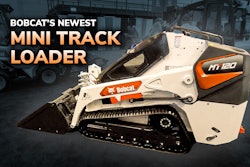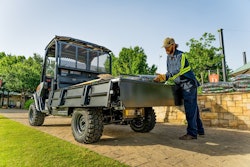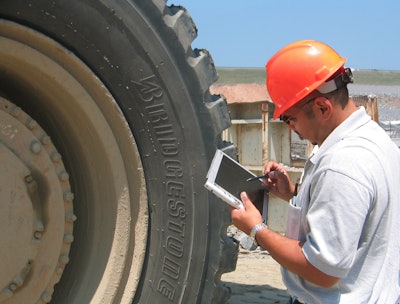 Tire inspections and record keeping enable you to get a true picture of how well your tires are holding up.
Tire inspections and record keeping enable you to get a true picture of how well your tires are holding up.
There are two truths every contractor or fleet manager should know about tires.
1. Tires are expensive. After fuel and wages, tires are your biggest operating expense; bigger than maintenance, oil changes and all the rest.
2. Most tires don’t wear out. They’re run to destruction. In other words, you’re often not getting your full dollar value out of most of your tires.
The solution is a tire management program. It’s not rocket science, but you do need a methodical approach to spec’ing tires, educating operators, analyzing why your tires fail and taking corrective measures to reduce or eliminate problems.
There’s no exact formula for determining the scope and content of your own tire management program. You can outsource the whole enterprise to your tire dealer, or you can do it all in-house. It really depends on the nature of your company and how involved you want to become, says Roger Best, Manager, OTR OEM Engineering, Bridgestone Commercial Solutions.
“A tire program should be tied to your maintenance program, because tires are a maintenance item, just like changing the oil,” Best says.
The most effective programs are negotiated between servicing dealers and the end user, says Rick Johnson, Eastern OTR manager.
Analyze your issues
The causes of tire problems usually fall into one of several categories or combinations of them, says Dave Green, OTR product manager at Titan Tire Corporation. These can include improper tire selection, inadequate maintenance, poor operations or site conditions.
If you establish a baseline for tire performance and conduct a site analysis (including scrap tire analysis), you’ll have a better idea of what the causes of tire failure are and be able to identify solutions. Your tire dealer can help educate you on the more technical points of this analysis and point out issues that you may not be aware of, Green says.
Your tire dealer or equipment OEM can also inform you about the correct procedures and timing for tire rotation. You’ll also want to ask your dealer to detail the best strategy for repair vs. replacement. Off road tires can be repaired and some can be retreaded, but not if the tread is too worn or damaged. Finessing this formula can save you a lot of money but it takes a good, detailed tire program and analysis.
Get it in a grid
Figuring out the best tire spec for a particular application is always going to be guesswork until you develop a tire tracking and monitoring program. Most of the major tire vendors have software programs or websites that enable you to do this.
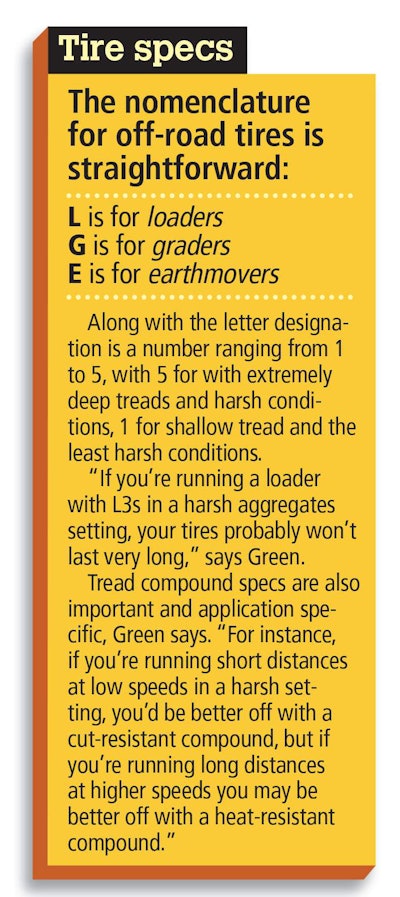
What you want to do is record all the types of tires you have, the type of machine they’re on, the applications and sites they’re working in, their maintenance and when they failed or wore out and why.
It takes some time to build up a database, but eventually you’ll be able to prove which tires are the best fits for various conditions and applications. Until you have the data, though, you’re just guessing.
Michelin recommends you find a tire management software program that is easy to use – logically laid out and easy to understand. Reporting is the heart of the program so look for one that gives you a variety of formats and options and includes inventory reports, performance reports, budgets and forecasts, fleet and inspection reports, failure/damage reports and consolidation of results from multiple jobsites. Web based programs enable you to enter data from any computer or connected digital device.
With a tire dealer supplied tire management program you can also identify any problems in your tire maintenance regime, says Green, things like improper inflation pressure, inadequate rotation schedule, etc. Guidelines for tire rotation vary depending on the equipment, so it’s best to follow manufacturers recommendations, he says.
Inflation is primary
Tire people harp on inflation pressure constantly – and for good reason. An under or over-inflated earthmover tire is dangerous. “There is some wiggle room on inflation pressure for passenger car tires, but not for off-road,” Best says. “At a lot of the smaller job sites, they may only check air pressure once a month,” he says. “But in 30 days if you lose just a pound of pressure a day, that’s 30 pounds and you could have a serious problem and not know about it until it’s too late.”
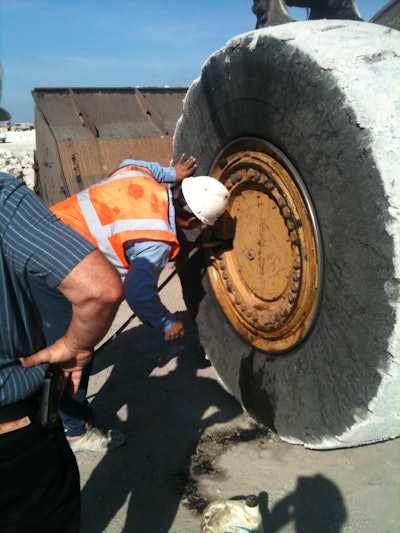 At a minimum you or your operators should check your earthmover tires’ air pressure once a week. Daily is better.
At a minimum you or your operators should check your earthmover tires’ air pressure once a week. Daily is better.An under-inflated earthmover tire overheats easily, reduces your equipment’s carrying capacity and is more likely to experience damage and premature failure.
All the experts agree air pressure should be checked at a minimum once a week. Daily air pressure checks are better and recommended by MSHA. If your operators do pre-shift vehicle inspections that’s the perfect time to check tire pressure. Also make sure your operators document any abnormalities or items that need to be corrected, says Johnson.
If you maintain the right air pressure and spec the right tires, the only other thing you have to do to extend the life of your tires is maintain clean worksites and train your operators.
Mining companies maintain exacting standards when it comes to haul roads and load site conditions and for good reason: they may be paying up to $30,000 a piece for the tires on their big haul trucks.
“Ideally, eight percent should be the maximum grade,” Best says. Any higher and you have the possibility of spinning the tires and loss of traction or loss of vehicle control.” The crown on the road is also important for water drainage and you want to have the road at least three vehicles wide, so drivers can avoid spillage, he says. Also the straighter the road, the easier it is on the tires.
Load and dump sites should also be swept clean with a loader or motor grader as well. When subject to the intense loads put on an earthmoving machine rocks and other innocuous looking debris can cut tires or become wedged between treads and work their way into the tire casing.
And don’t forget that wet conditions can exacerbate cutting problems with tires.
Overloads and over-speeds are also frequent contributors to tire failures, says Johnson. Tires are all designed to perform according to applications, loads and speed. Making sure a tire is within its designated specifications will prevent unnecessary failures and increase productivity, he says. This means you, or somebody in operations should train drivers to follow OEM recommended speeds and loading capacities for these types of machines. Even if the performance of the drivers is not your responsibility, their skill or lack of it, impacts your budget.











